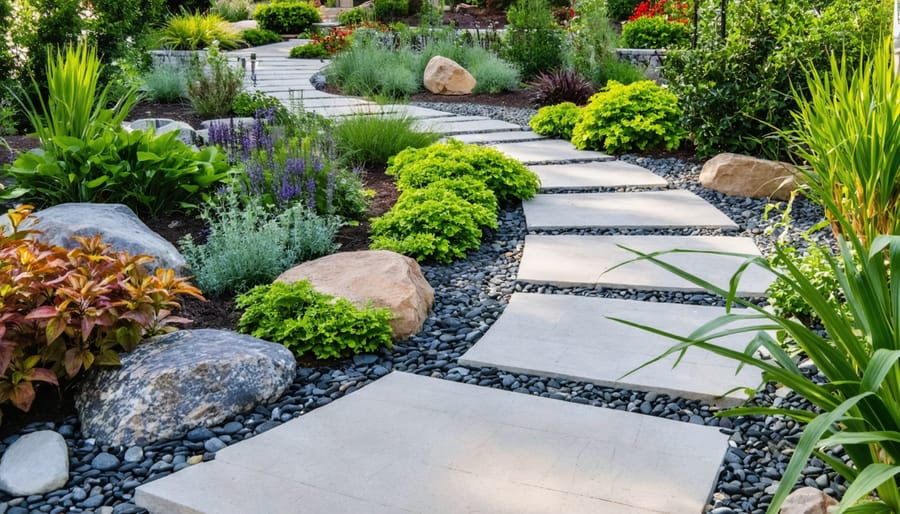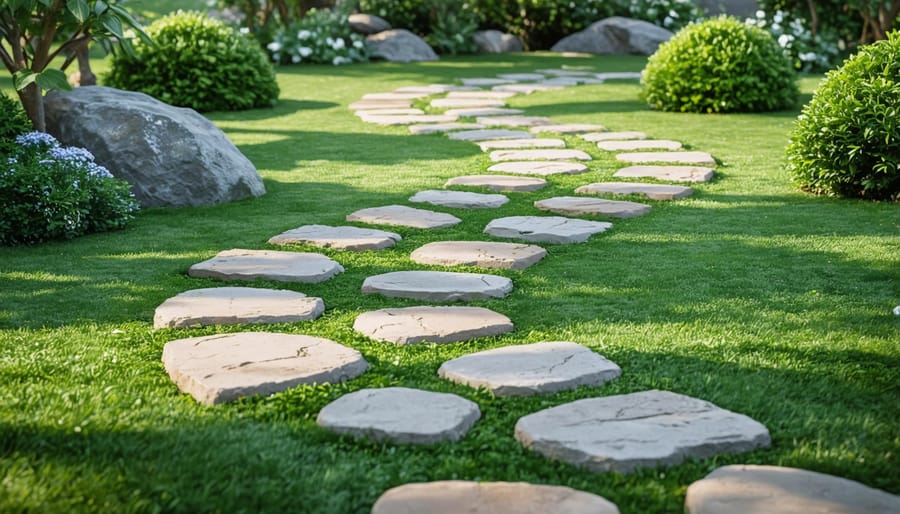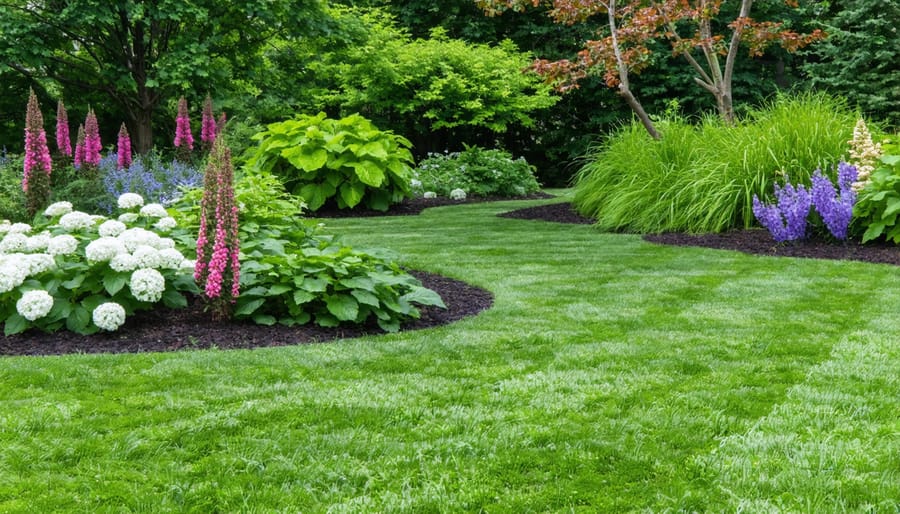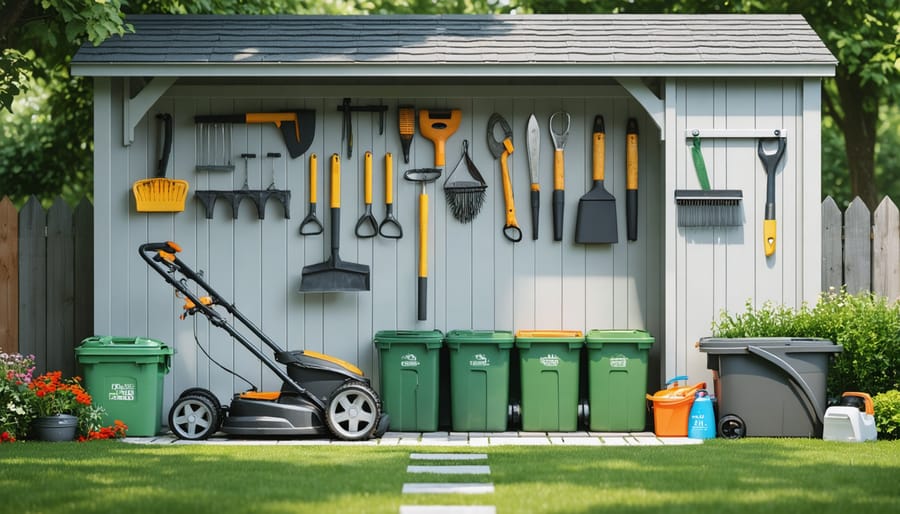Transform Your Lawn Into an Eco-Paradise Without Breaking the Bank

Transform your lawn into an eco-friendly oasis by replacing chemical fertilizers with organic compost tea, reducing water consumption through smart irrigation systems, and incorporating native plant species. Modern eco-friendly lawn care combines sustainable practices with beautiful design, creating outdoor spaces that protect our environment while demanding less maintenance. Strategic hardscaping elements like permeable pavers and rain gardens naturally filter water runoff, while drought-resistant groundcovers reduce the need for traditional grass areas. Whether you’re redesigning your entire yard or making small improvements, embracing eco-friendly lawn care not only cuts down on resource consumption and maintenance costs but also creates a healthier space for your family and local wildlife. The key to success lies in choosing the right combination of sustainable materials, water-wise plants, and natural maintenance methods that work together to create a thriving, environmentally responsible landscape.
Smart Water Management Through Hardscaping
Permeable Pathways and Natural Drainage
Creating paths and walkways that allow water to naturally seep into the ground is a smart way to manage rainwater while maintaining a beautiful lawn. Consider using materials like permeable pavers, gravel, or crushed stone for your pathways, which allow water to filter through rather than run off. These materials create an attractive, natural look while helping prevent flooding and water pooling.
For natural drainage solutions, incorporate rain gardens in low-lying areas of your yard. These shallow depressions filled with native plants help collect and filter rainwater, reducing erosion and supporting local wildlife. Strategic placement of river rocks and water-loving plants can create beautiful drainage channels that direct water flow while adding visual interest to your landscape.
Another effective approach is to install a dry creek bed, which mimics natural waterways and provides excellent drainage during heavy rains. Line the bed with different-sized rocks and pebbles, and add native plants along the edges to create a naturalistic look. These features not only solve drainage issues but also become stunning focal points in your eco-friendly yard.

Rain Gardens and Bio-Swales
Rain gardens and bio-swales are nature’s solution to managing water runoff while creating beautiful, eco-friendly landscaping features. These shallow depressions in your yard collect rainwater from roofs, driveways, and other hard surfaces, allowing it to slowly filter into the ground instead of rushing into storm drains.
Creating a rain garden is simpler than you might think. Start by selecting a spot at least 10 feet from your home’s foundation where water naturally collects. Layer the depression with native plants that thrive in both wet and dry conditions, such as black-eyed susans, cardinal flowers, or native grasses. These plants not only look stunning but also help filter pollutants from the water.
Bio-swales work similarly but are designed as long, gently sloped channels that direct water flow. They’re perfect for property edges or alongside driveways. Both features reduce erosion, support local wildlife, and decrease your lawn’s maintenance needs. Plus, they add natural beauty to your yard while helping protect local waterways from harmful runoff.
Consider adding decorative rocks or river stones to enhance the visual appeal and improve drainage. These sustainable solutions prove that eco-friendly choices can be both practical and beautiful.
Native Plant Integration
Low-Maintenance Ground Covers
Transform your lawn into a low-maintenance paradise by incorporating ground covers that align with sustainable garden practices. These alternatives to traditional grass not only reduce your maintenance workload but also contribute to a healthier ecosystem.
Creeping thyme offers a fragrant, purple-flowered carpet that thrives in sunny areas and can handle light foot traffic. For shaded spots, consider Japanese pachysandra or sweet woodruff, both providing dense coverage with minimal care requirements. Sedum, with its succulent leaves and colorful blooms, excels in drought conditions and poor soil.
Clover makes an excellent grass alternative, naturally fixing nitrogen in the soil and requiring no fertilization. It stays green throughout the season and rarely needs mowing. For slopes or areas prone to erosion, try creeping juniper or ornamental strawberry, which develop strong root systems to stabilize soil.
These ground covers naturally suppress weeds, reduce water consumption, and eliminate the need for chemical treatments. Most require only annual trimming to maintain their shape, saving you time and energy while creating a beautiful, eco-friendly landscape that complements your outdoor space.

Strategic Plant Placement
Strategic plant placement is a game-changer for creating an eco-friendly lawn that works smarter, not harder. By thoughtfully positioning trees, shrubs, and other plants, you can naturally regulate your yard’s temperature and protect your soil without relying on chemical solutions or excessive watering.
Consider planting deciduous trees on the southern and western sides of your property. During summer, their full canopies provide cooling shade that reduces water evaporation and protects your lawn from harsh afternoon sun. In winter, these same trees lose their leaves, allowing beneficial sunlight to warm your home and yard.
Ground covers and low-growing plants work wonders for soil protection. Place them strategically in areas prone to erosion or where grass struggles to grow. They’ll help prevent soil runoff, retain moisture, and create natural barriers against weeds. Native plants are particularly effective as they’re already adapted to your local climate and require minimal maintenance.
Create natural windbreaks by positioning taller shrubs and evergreens along the prevailing wind direction. This reduces soil moisture loss and protects more delicate plants. Remember to leave enough space between plants for proper growth and air circulation, which helps prevent fungal issues and promotes healthy root development.
Natural Lawn Care Solutions
Organic Fertilization Methods
Natural fertilization methods offer a safe and effective way to nourish your lawn while protecting the environment. One of the simplest organic approaches is grasscycling – leaving grass clippings on your lawn after mowing. These clippings break down quickly, returning valuable nutrients to the soil and reducing the need for additional fertilizers.
Compost is another excellent organic fertilizer that improves soil structure while feeding your lawn. Create your own by mixing fallen leaves, grass clippings, and kitchen scraps (excluding meat and dairy). Apply a thin layer of finished compost in spring and fall for best results.
Many homeowners have found success with organic alternatives like bone meal, which provides phosphorus for strong root development, and blood meal, which offers a natural nitrogen boost. Seaweed or kelp meal adds essential micronutrients and helps strengthen grass against drought and disease.
For those seeking ready-to-use options, look for organic fertilizers made from natural ingredients like alfalfa, cottonseed meal, or composted poultry manure. These products release nutrients slowly, preventing the rapid growth spurts and subsequent crashes common with chemical fertilizers.
Remember to test your soil before applying any fertilizer, organic or otherwise. This helps you understand exactly what nutrients your lawn needs, preventing over-fertilization and ensuring your organic amendments are as effective as possible.
Natural Pest Control
Nature provides excellent solutions for pest control, and incorporating these methods into your lawn care routine can help maintain a healthy garden without harmful chemicals. Beneficial insects like ladybugs, praying mantises, and parasitic wasps act as natural predators, keeping problematic pest populations in check. You can attract these helpful creatures by creating diverse habitats with native flowering plants and herbs.
Companion planting is another effective strategy for natural pest management. Plant marigolds throughout your lawn and garden beds to repel nematodes and other harmful insects. Lavender not only adds beauty to your landscape but also deters moths and flies. Chrysanthemums contain pyrethrin, a natural insecticide that helps control ants, roaches, and ticks.
Consider creating a herb garden section in your lawn, as many herbs naturally repel pests. Mint deters ants and mice, while basil keeps mosquitoes and flies away. Rosemary and thyme help protect your garden from cabbage moths and carrot flies.
To maintain this natural ecosystem, avoid using chemical pesticides that could harm beneficial insects. Instead, encourage birds to visit your yard by installing birdhouses and baths. Birds are excellent natural pest controllers and add wonderful movement and song to your outdoor space. Remember that a healthy, diverse garden is naturally more resistant to pest problems, so focus on building soil health and maintaining plant diversity.
Storage Solutions for Eco-Friendly Tools
Proper storage of your eco-friendly lawn care equipment not only extends its lifespan but also helps maintain its effectiveness. Start by organizing your garden tools in a dedicated space that’s protected from the elements.
For manual tools like rakes, shovels, and push mowers, install wall-mounted racks or pegboards to keep them off the ground and easily accessible. Consider using recycled materials like wooden pallets to create custom storage solutions that align with your eco-friendly approach.
Battery-powered equipment requires special attention. Store batteries in a temperature-controlled environment, ideally between 40-70°F, away from direct sunlight. Install shelving units specifically for battery storage and charging stations, ensuring proper ventilation to prevent overheating.
Create designated zones for different categories of tools: one area for daily-use items, another for seasonal equipment, and a separate space for organic fertilizers and natural pest control solutions. Use clear, airtight containers for storing organic materials and label them clearly.
Remember to include a small workbench area for maintaining your tools. Regular cleaning and upkeep of eco-friendly equipment ensures optimal performance and longevity. Consider adding a rain barrel near your storage area to collect water for cleaning tools and watering your lawn.
Keep a basic tool maintenance kit nearby, including natural cleaning solutions, organic lubricants, and spare parts for your most-used equipment. This organized approach will make your eco-friendly lawn care routine more efficient and enjoyable.

Embracing eco-friendly lawn care practices isn’t just good for the environment – it’s a smart investment in your property’s future. By implementing natural fertilizers, water-wise irrigation methods, and sustainable mowing practices, you’ll create a healthier, more resilient lawn that requires less maintenance over time. The reduced need for chemical treatments means safer spaces for your family, pets, and local wildlife. Best of all, these green practices often lead to significant cost savings through lower water bills and reduced maintenance expenses. Take the first step today by incorporating just one or two sustainable methods into your routine. As you witness the positive changes in your lawn’s health and appearance, you’ll find it easier to embrace more eco-friendly practices, creating a beautiful outdoor space that you can feel good about maintaining.

